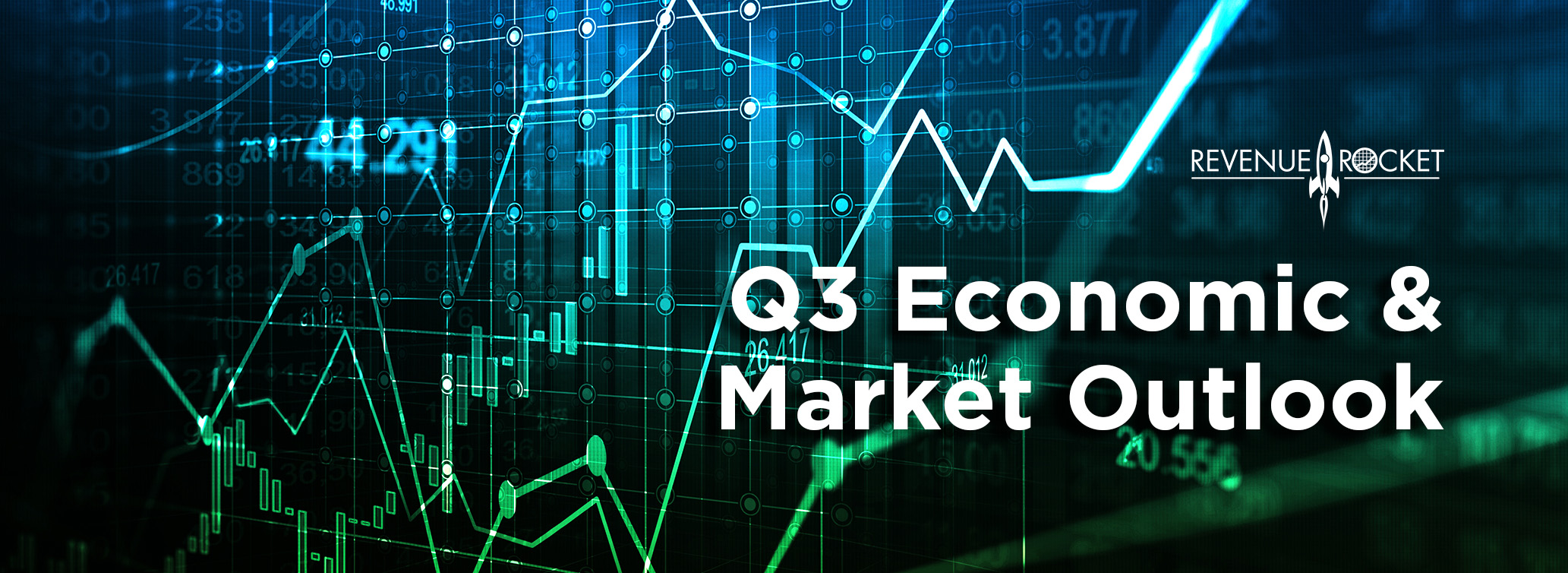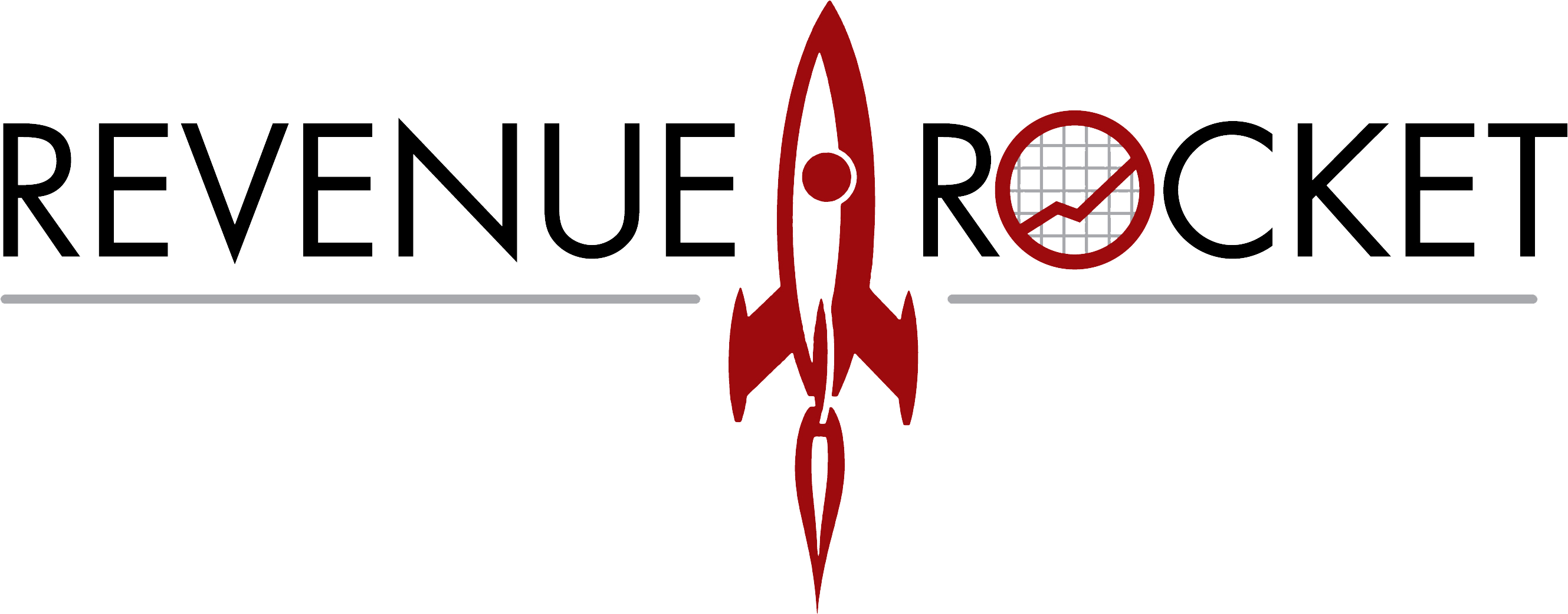
24 Jun From Revenue Rocket’s Chief Economist: Q3 2024 Economic & Market Outlook
The M&A Deal Window is still open- but clouds are gathering…
After an explosive equity rally in Q1 and flat Q2, the wealth effect has investor confidence running high across most asset classes. The markets were able to absorb the shift of timing of interest rate cuts to late 2024; however, recent data suggests we sit on the precipice of an economic pivot as consumer confidence (and likely spending) heads much lower.
Nonetheless, the stable yield environment and continued risk-on mindset has maintained a solid environment to get M&A deals done through early Q3. The window is open for deal flow, but clouds are on the horizon.
Market Expectations:
Interest Rates:
The US Treasury continues significant debt issuance ($2T per annum) requiring the bond market to absorb more supply (at likely higher rates). The bond market has started to pay attention to debt issuance, with heightened concern about both Biden’s and Trump’s spending/tax cut promises to voters. This places an underlying upward lift on long-term rates. We expect a flattening of the yield-curve over the next six months (short-term rates falling, 2-7 year flat, 10+ year increasing to approximately 4.5% across the yield curve).
Inflation has been stickier than expected, but underlying data suggests the inflation wave has dissipated. However, wage price inflation will be very difficult to slow in 2024. We predict only one 25bps cut after the election (December). An additional 25bps cut before the election is possible if the unemployment rate spikes significantly over the summer and the FED attempts to copy the EU and do a risky pre-exemptive unemployment related cut (even though inflation isn’t in the range). The BLS job report volatility and conflicting results are injecting increased risk on the state of the labor market. We believe the labor market is much weaker than the BLS job reports suggest.
VIX/Volatility:
Normally, election years are positive for risk assets, however, 2024 will likely be different given the lack of serious GOP challengers to Trump and Democratic challengers to Biden. We have seen the VIX trade to the lowest levels in years in Q2. The markets have likely already absorbed the policy volatility dividend from the end of the election cycle. Although the Biden administration has taken steps to lower Oil/gas volatility through SPR; we expect these to end in Q3 with more volatility in the oil markets due to last ditch climate initiatives by the EPA, lower Oil CapEx (thus future production), and higher demand from summer driving and China. Even with record US Oil production, refilling the SPR will become political over the summer as election rhetoric and gas prices start to rise. Even with the announced gasoline stockpile release, we expect gas prices to put more stress on stretched consumers and slow dis-inflation in the late summer.
Liquidity:
The FED will continue quantitative tightening (QT) levels through Q2, putting funding stress on bank lending markets. However, after many years of excess bank reserves throughout the banking system, this will only impact lending on the margin. Expect an announcement in Q3 to slow QT to smooth late summer liquidity stress (this will likely be used in lieu of a September rate cut if inflation does not continue to decline).
We expect lending standards to continue to tighten through Q3. However, private credit will fill this void given the significant cash on the sidelines available to be invested (if the risk/return profile is appropriate. This credit will come with a significant cost- high rates, covenants, and equity conversion provisions). However, as election rhetoric heats up in Q3/Q4, and summer financial activity dies down, liquidity will disappear in September/October and funding/refinancing could get very dicey. We recommend securing funding now while it is available and refinance later.
Deal Flow (Supply/Demand):
After almost three years of a sellers’ market, we expect deal leverage to move towards buyers. We continue to expect sellers who had been waiting on the sidelines to enter the market with the recognition that they have missed the top and do not want to run the business through the next downcycle. This will increase the supply of firms available.
On the demand side, we expect the market to see some new strategic entrants, as they finally see reasonable values and investment return profiles. We continue to see cashflow as king, over revenue growth in Q2 /Q3 of 2024, however, as rates fall in late H2- look for this to begin shifting back to revenue growth towards 2025. At RRCG, we have already begun to see expanded demand from buyers re-entering the market.
As interest rates remain elevated through Q2, we expect PE firms to remain on the sidelines unless they have investment deadlines from pandemic capital raises. Overall, we think the market will come into balance, resulting in more pressure on sellers and lower EV values/prices; nonetheless we expect higher EBITDA margin companies will continue to receive a premium. We do not expect significant price dislocation in Q3 but are concerned about Q4 and 2025.
Prediction Risks: Early Q3 looks stable, with quarter end bumpiness and Q4 looking dicey
Upside Risk (30%):
“No Landing”- The upside risk to the economy is associated with moderating economic growth, in line with a slow and predictable decline in inflation and interest rates. The economy would likely downshift from high-gear to a lower-gear while still moving forward with reasonable margins. Lower inflation and interest rates, with solid growth and margins would create a foundation for higher risk asset valuations and increase the likelihood of additional lending/leverage being brought to the marketplace as rates slowly decline in Q2-Q3. Moderated and slow FED interest rate cuts would unleash animal spirits as the all-clear sign is sounded for risk assets. This would be constructive equity markets, but we wouldn’t expect a signficiant move to higher private market EV values given liquidity pressures in funding/loan markets.
Downside Risk (70%):
Energy Boiling the Frog- Downside risk could come from an accelerating rise (not shock) in oil prices (lower production vs demand, expanded wars, tanker spill, China GDP growth) which prevents the FED from moving forward on multiple rates cuts. The increase in cost of living could result in lowered consumer confidence and spending, setting off an unemployment cycle which could ravage GDP/earnings. We do not expect this would materialize until early fall, as energy supplies/stocks remain solid given the warmer than expected winter and slower Chinese economic recovery. However, it is notable that global energy stockpiles declined in Q1 2024. Possible comparison to the historical oil/gas market, Q3-Q4 2007.
Commercial Real Estate Meltdown- We already saw this risk poke its head up with the meltdown of NYCB (New York Community Bank) in Q1. The entire industry knows that CMRE valuation marks are way off; the problem is no one knows exactly where the risk is concentrated. As we move closer to major refinancing of the CMRE debt in 2025, these marks will begin to show and price discovery will force mark downs and margin calls across the sector. This could squeeze liquidity and forced selling across all asset classes. Look for a significant “fire-sale” transaction or an REIT fund freezing redemptions to light the fuse here, causing a cascade of mark-to-market valuations…resulting in forced assets sales by regional banks and significant declines in equity, real estate, and riskier fixed income assets. We would expect to see the FED come to the rescue. However, the FED will have to allow some pain before riding to the rescue to preserve its credibility/reputation. This would have significant negative impacts on funding markets.
Maxxed Out- The US consumer hits a spending wall, as they approach credit limits across their credit facilities. This could lead to a very precipitous drop in spending and consumer confidence. This would set off an unemployment wave as businesses look to protect earnings. This would get aggressive in the October/November timeframe. Q1 and Q2 consumer credit stats suggest the consumer is rolling over, as consumer credit contracted versus 2023. Historically, 4-month contractions in consumer credit have resulted in recessions- need to keep on eye on revolving debt (we have already seen this in Q1 and Q2 2024)….Credit has contracted in each month Jan-March, with only a slight increase in April per FED reporting.
Economic Conundrum (The data is wrong?)- The economy is struggling with a conundrum, expanding job reports with higher unemployment rates. We believe there is a slowdown in hiring and an uptick in layoffs. However, the impact of this slowdown is being masked in GDP by higher wages and many Americans taking on second jobs (thus the higher job reports) to cope with high consumer prices. We expect this trend to continue through Q3, until lower overall consumer demand shuts off the second job market and kicks off the spending contraction cycle caused by loss of second incomes and maxxed out credit cards/consumer credit. The market has not sniffed out why there is a disconnect between unemployment rate increases, jobs data, and consumer sentiment, but time will reveal the answer over the summer (watch discussion on incorrect birth/death rate in the BLS model and trade-down in consumer spending- Target vs Wal-mart, TJ Maxx vs Macy’s, lower revenue at Dollar Tree/General for consumer weakness).
Conclusion:
If you are a seller, get off the fence, get in the market, and get deals done in 2024; otherwise, you may have to manage through the next down cycle (which could be 2-3 years long). If you are a buyer: secure funding, get the process started by developing a strategic acquisition approach, and start the search process. There will be supply and some distressed opportunities available for buyers that are ready to pull the trigger. However, these opportunities will likely exist for very short periods- so be ready to pounce. Overall, the window is open right now to get deals done at reasonable prices and high returns, but storm clouds are building on the horizon as we approach year-end.
**This is Revenue Rockets opinion from Revenue Rockets Chief Economist, CJ Strehl**


